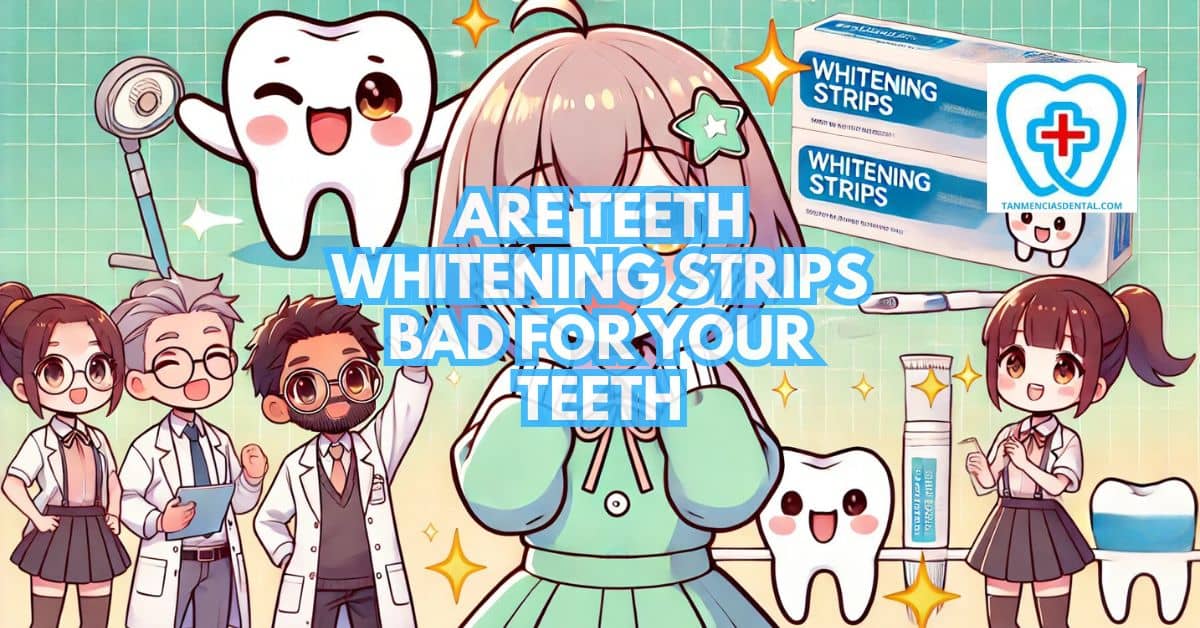Teeth whitening strips have become a popular method for achieving a brighter smile, available at nearly every pharmacy.
While they’re convenient and can show quick results, many people worry about the potential harm to their teeth.
The main concern is whether these products can cause long-term damage to enamel or lead to other oral health issues.
Whitening strips use chemicals to bleach the teeth, which may have side effects depending on usage and individual tooth sensitivity.
Let’s break down the potential risks and benefits to help you decide if whitening strips are a good choice for your smile.
1. Do Whitening Strips Really Work?
Whitening strips are designed to break down stains on the tooth surface using active chemicals, primarily hydrogen peroxide or carbamide peroxide.
These chemicals penetrate the enamel, reaching stains within the teeth and making them less visible over time.
Results vary; for some, whitening strips can brighten teeth several shades, while others see only minor changes.
Effectiveness depends on factors like stain type, tooth condition, and the strip’s formula.
Whitening strips often work best on surface stains from food or drink but may not be effective for deeply embedded or natural discoloration.
🦷 How Do Dentists Clean Teeth With Braces? A Behind-the-Scenes Look at Dental Care!
2. Decoding the Ingredients: What’s in Your Whitening Strips?
The main ingredients in whitening strips are hydrogen peroxide or carbamide peroxide, both of which act as bleaching agents to remove stains.
These chemicals work by breaking down colored compounds within the enamel, leading to a whiter appearance.
Hydrogen peroxide is generally faster-acting, while carbamide peroxide releases whitening effects over a longer period.
Other ingredients may include binders to help strips stick to teeth and flavorings for a more pleasant taste.
Understanding what’s in these strips can help you choose a product that balances effectiveness with safety for your dental needs.
🦷 Best Drinks for Teeth: How to Quench Your Thirst and Protect Your Smile
3. The Perils of Overuse: Can Whitening Strips Damage Enamel?
Using whitening strips too often can lead to the gradual thinning of enamel, the hard protective layer on your teeth.
Enamel erosion increases the risk of cavities, sensitivity, and discoloration over time as the inner layers of the tooth become more exposed.
Whitening strips are generally safe when used as directed, but repeated or extended use can heighten the chance of enamel damage.
Many people mistakenly believe that more frequent application will lead to faster results, but this approach may harm their teeth.
Following instructions and limiting use is essential to maintaining both effectiveness and safety for your teeth.
🦷 Winning the Battle Against Dry Mouth and Gingivitis
4. The Sensitivity Factor: Whitening Strips and Tooth Discomfort
One common side effect of whitening strips is tooth sensitivity, which can be uncomfortable or even painful for some users.
The bleaching agents in the strips can temporarily irritate the nerves within the teeth, particularly for people who already experience sensitivity.
This discomfort is often triggered by hot, cold, or acidic foods and drinks, lasting for hours or even days after using the strips.
Some strips come in lower strengths to reduce the chance of sensitivity, and using them less frequently may also help.
If sensitivity is a major issue, consulting a dentist about alternative whitening methods might be a better option.
🦷 Are Dentists Open On Bank Holidays? What You Need to Know Before You Plan Your Visit
5. Whitening Limits: What Won’t Change Color?
Whitening strips are designed to lighten the color of natural tooth enamel but are ineffective on dental restorations like crowns, veneers, and fillings.
These materials do not react to the bleaching agents in the same way that natural teeth do, meaning they will remain the same color even as the surrounding teeth whiten.
As a result, people with dental work may notice uneven coloring if they use whitening strips.
This limitation is important to consider for anyone with visible dental restorations, as it may affect the overall appearance of their smile.
For those concerned about color matching, a dentist can offer advice on more suitable whitening options.
🦷 Can You Drink Green Tea After Brushing Your Teeth?
6. Kids and Whitening Strips: A Risky Business?
Teeth whitening strips are generally not recommended for children, as their enamel is thinner and more sensitive than that of adults.
Using these products at a young age could result in lasting enamel damage, making teeth more vulnerable to cavities and sensitivity as they grow older.
Additionally, many whitening products are not formulated with younger, developing teeth in mind, which can pose further risks.
Parents should consult a dentist before considering any whitening treatments for their children, as there may be safe, age-appropriate options available.
Avoiding whitening strips until adulthood can help protect children’s dental health in the long term.
🦷 The Best Food For Gums And Teeth: Nourishing Your Smile
7. Teens and Whitening: Striking a Balance
For teens, whitening strips can seem like an easy way to improve their appearance, but caution is advised due to the developing nature of their teeth.
Teenagers’ enamel is still maturing, and bleaching agents can wear down this enamel or cause increased sensitivity if not used correctly.
Limiting the use of whitening strips and choosing milder formulas can help reduce potential risks while still providing some whitening effect.
It’s a good idea for teens to discuss any whitening plans with a dentist, who can guide them toward safe, effective choices.
Striking a balance between enhancing appearance and protecting teeth is key for teens using whitening products.
🦷 Conquering Your Phobia of Brushing Teeth: Overcoming Fear for a Healthier Smile
8. Beyond the Strips: Exploring Other Whitening Options
While whitening strips are popular, they are just one of several methods available for teeth whitening.
Alternatives include professional treatments from a dentist, such as laser whitening or custom-fitted whitening trays, which often deliver faster and more even results.
There are also over-the-counter whitening toothpastes and mouthwashes, which can help with minor stains, though they generally don’t achieve the same brightness as strips or in-office treatments.
Each option varies in cost, effectiveness, and potential side effects, making it important to weigh the pros and cons of each.
Consulting a dentist can help in choosing a method that aligns with your needs and dental health.
🦷 Can Dentists Tell You Smoke? Understanding the Oral Signs of Smoking Habits
9. Maintaining a Bright Smile: The Role of Oral Hygiene
Good oral hygiene is essential for keeping your teeth white and healthy, with or without whitening products.
Brushing twice daily with fluoride toothpaste, flossing, and regular dental cleanings all help prevent plaque buildup and stains.
Avoiding foods and drinks that stain, like coffee, tea, and wine, can also prolong the effects of whitening treatments.
Practicing these habits can reduce the need for frequent whitening and protect your enamel from damage.
A strong oral hygiene routine supports overall dental health and helps maintain a bright, natural-looking smile.
🦷 Can I Eat After Brushing My Teeth At Night?
10. Seeking Expert Advice: Why Consulting a Dentist Matters
Before starting any whitening treatment, it’s important to consult a dentist to assess your individual dental health and needs.
A dentist can identify any underlying issues, such as cavities or gum disease, which should be treated before beginning a whitening routine.
Dentists can also recommend whitening methods tailored to your teeth and sensitivity level, reducing the risk of enamel damage and sensitivity.
Regular checkups allow your dentist to monitor the health of your teeth and address any issues that arise from whitening.
Expert advice ensures that whitening doesn’t compromise your oral health in the long term.
🦷 Tan-Mencias Dental Clinic Marikina
👨⚕️ Conclusion
Teeth whitening strips can offer a brighter smile but come with certain risks, especially when used improperly or too frequently.
They are generally safe when used as directed, but potential side effects like sensitivity or enamel erosion make it essential to follow guidelines closely.
By understanding the benefits and drawbacks, you can decide if whitening strips or an alternative option is best for you.
Pairing whitening products with good dental habits helps protect your teeth while enhancing their appearance.
Ultimately, whitening can be safe and effective with the right approach and professional guidance.
😊 Self-Promotion
Looking for quality dental care in Parang, Marikina City?
Visit Tan-Mencias Dental Clinic for a full range of dental services in a friendly, comfortable setting.
Our team is here to answer any questions and help you achieve your best smile!
Feel free to reach out by calling us at 9171451074, sending a message through our Facebook page, or filling out the contact form on our website.
We look forward to seeing you soon!

